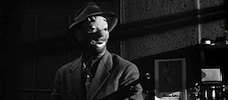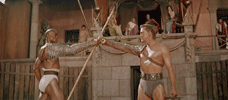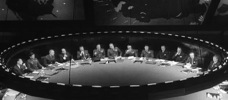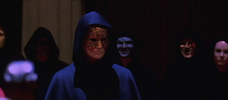Reviews
Artificial Intelligence
Steven Spielberg
USA, 2001
Credits
Review by Aaron Cutler
Posted on 16 March 2010
Source Dreamworks Video DVD
Categories Kubrick
There’s a small moment about midway through A.I. Artificial Intelligence that sums up the film. A talking toy bear named Teddy, separated from its owner at a carnival, is dragged off to the Lost-and-Found. “Do you know David?” it asks, then “Then could you help me find David?”, finally collapsing into “I have to find David.” The fair employee, meanwhile, wonders where the “off” switch is. The moment is simultaneously heartbreaking and befuddling, because while Teddy’s expressing a very recognizable, quite human emotion (specifically a child’s fear of being torn from its parent, or a more general fear of being torn from a loved one), we know that David, the longed-for, isn’t human—he’s a brand-name robot. A robot shouldn’t feel emotions like love or despair, but we know, watching the scene, that David misses Teddy, too. Yet if anything, Teddy should be several more layers removed from human feeling than David is: He is not human, but a bear; and not a bear, but a teddy bear; and not even a soft plush teddy bear as we typically think of them, but a new mechanical model. We’re not just watching a simulacrum, but a reproduction of a simulacrum, expressing a wish to be with a simulacrum of its own.
That we impute desire to the bear beyond software suggests how powerfully we ourselves connect with Teddy, and by extension with David. Throughout the film David expresses the Pinocchio-like wish to become a real boy, and one might respond that David and Teddy are still not real, even as they long for each other’s company. Yet this seems problematic—within the film they are physical objects existing in real space, after all, and imputing a dream life to a mechanical object is exactly what we do whenever we watch a movie. One might say the world that the film suggests is not real, but we would never say that the film itself isn’t. Similarly, human imagination can’t be pinned to a wall or weighed on a scale, even while humans walk in full, fleshy form. David can walk, talk, and think just like the people surrounding him - to the point, in fact, where he is often mistaken for one - and our dual awareness of what he is and wants to be informs the film. The Toy Story movies, by keeping the humans essentially offscreen, let us entertain the illusion that the cartoon toys Buzz and Woody are human; even the definitive cut of Blade Runner keeps Rick Deckard’s identity (human or replica?) ambiguous, so that we can identify with what we think is a man as he hunts down androids. David and the film’s other robot characters stay constantly aware that they are not human—what we might think of as real. But the film takes their side, firmly, so that they seem more human than humans, and in doing so challenges what we mean when we call something, or someone, real.
You might say that a quality of much strong art - particularly the kind that we think of as humanist - is its ability to compel identification with a perspective other than our own. You might say, furthermore, that A.I.’s oppressed mechas (as opposed to its ruling-class humans, called orgas) allegorically stand in for racial or religious minorities, immigrants, the poor, or any underrepresented social class. Yet I’d say in response that A.I. blurs the us-and-them dichotomy especially after the fashion of Stanley Kubrick, the film’s progenitor. The watchword for Kubrick’s films for me has always been “mediation”; whether they’re separated by physical location (Dr. Strangelove), a moment in time (The Killing), class (Barry Lyndon, Spartacus), gender and sexuality (Lolita, Eyes Wide Shut), sheer incommunicable psychic trauma (Full Metal Jacket, The Shining), or, indeed, level of humanity (2001: A Space Odyssey), his characters address each other across unbridgeable gulfs. With his distant camera and long takes, the director seems like he’s observing them to see what he can learn—when I watch his later films I sometimes think of a man knocking at a skull and asking what’s inside. Some call this observational curiosity and willingness to study people cold, or clinical, but for my part I find it enormously empathetic.
If you’re reading this review, though, then you likely know that, technically, A.I. isn’t a Kubrick film. Kubrick had been thinking about the movie (based on a Brian Aldiss short story) since at least the mid-’80s, but from early on had wanted Steven Spielberg to direct it. Spielberg only took up the project after Kubrick died in 1999, and the finished 2001 product doesn’t feature Kubrick’s name on the credits save for a dedication.
The story is about a robot boy, David (Haley Joel Osment), who learns to love his human mother (Frances O’Connor), and who then tries to relocate her once she abandons him in the woods. Kubrick wanted Spielberg, he claimed, because he believed Spielberg could bring a more sympathetic hand to the material. One could see David’s quest for his mother as mistrustful people try to destroy him as parallel to E.T.’s journey homeward, and see where Kubrick was coming from. Save Close Encounters of the Third Kind, A.I. is the only film Spielberg’s ever directed for which he’s also received sole screenplay credit. Its story is similar to many of his other movies—a child searches for his lost parent, or vice-versa, in E.T., The Sugarland Express, Empire of the Sun, the last two Indiana Jones movies, Saving Private Ryan, Minority Report, Catch Me If You Can, and War of the Worlds (plus Celie spends much of The Color Purple hoping to find her lost sister, and with Schindler’s List and the Holocaust Spielberg found a bonanza of separated families). A.I. must be recognized as a Spielberg movie, too.
It would be easy to give Spielberg the light and Kubrick the dark sides of A.I., and there are several instances where this is true: the film’s sex-and-murder urban settings are heavily influenced by Kubrick’s A Clockwork Orange, while the character of David’s mother, Monica, is more sympathetic than any female in a Kubrick film. Yet to do so would also ignore Kubrick’s hippie mysticism, which emerges in A.I.’s last part, just as it would ignore Spielberg’s contempt for the masses, which emerges in the film’s crowd scenes. It’s much more interesting to me to think of Kubrick’s technical interests folded into Spielberg’s bourgeois species interest, sometimes literally. After all, Kubrick wanted to have an actual robot play the part of David, while Spielberg decided to use a real human boy.
The film plays into this confusion the first time we see David, in a shot from Monica’s perspective, as a blur resembling a skinny-necked android: it pads forward, taking on human form, and smiles like a kid. We learn that David, a prototype (inventor William Hurt has declared in the film’s first scene that he’ll build a robot that can love), is substituting for Martin, Monica’s real son, who’s currently in a coma. In many instances we see David’s reflection in family photographs, reminding us he wasn’t part of them. (I’m indebted to this terrific visual essay for these connections.) Martin eventually wakes up and comes home, using mechanical pads to help him walk, looking more like a robot than David does; as the brat dares David to cut off a lock of Monica’s hair, we realize in a hurry that the two can’t coexist.
The immense disquiet in the film’s first part comes from watching the unfamiliar in a familiar setting. The curving staircase in David’s new home, the fresh clothes closet, the quiet dinner table: Kubrick was a Bronx boy, but Spielberg’s perhaps the single most perceptive American director when it comes to capturing the look and feel of the suburbs. David tries to fit into this world, and in some ways he succeeds—Monica’s shoving him into the closet, for instance, later repeats as a game of hide-and-seek. In other ways he doesn’t—he tries laughing at the dinner table, and the laugh goes on too loudly and for too long. When Martin eats spinach, David does so as well, and nearly destroys himself. There are some things that a mecha isn’t programmed to do.
What he is programmed to do is love, which is why Monica leaving him behind in the woods, running back to the car as he chases after her, is so upsetting. In his review of the film, Roger Ebert criticized Spielberg for assuming David’s perspective from this point onwards, arguing that it would be more interesting to see a person learn to love a robot than to watch the robot love humans. But Spielberg has in fact done this—once Monica drops out of the movie, we’re suddenly in her place. David’s mother has already refused to accept him; the question is whether we, the audience, will.
The film introduces a series of foils against whom David seems more human, which may seem like easing the issue of whether we accept David as real (it’s easier to love someone who can pass), but in fact complicates it by reminding us how David blurs categories, both robot and human. (Imagine being hard-wired to feel love or pain; it may not be hard to do so, as Hurt asks, “Didn’t God program Adam to love him?”) When the film shows mechas from now on, they’re either damaged so that we can see their wiring or designed so transparently that we don’t need to. David encounters several of both at the Flesh Fair, a sort of Pleasure Island where the crowd takes delight in seeing robots smashed to bits. He screams not to be injured, and the crowd acts up—it’s not just that they think David’s an orga, it’s that they wouldn’t want to reckon with his pain even if they thought he was mecha. Later on, David encounters a replica of himself, and smashes it, screaming, “I’m David!” Suddenly, in controlling another robot’s fate, David has taken on the role of the Flesh Fair patrons, and our allegiance to him becomes as one human to another—until he walks into the next room, and sees thousands more replicas.
Why do we value this David, let alone any version? It helps that Osment is an appealing actor, and that we spend a great deal of time with him. In my own case, Osment’s uncanny resemblance to my half-brother, along with the fact that his mother is named Monica, and that our father is named David, invests me in A.I. oedipally in ways that the film couldn’t have anticipated. Yet the human impulse generally is towards identification and, as with any protagonist, all viewers will likely find some aspect of David with which to identify. Walter Benjamin argued that a work of art loses its value as an original once it starts being reproduced; but even if thousands of copies of a book exist, your creased, beat-up copy is particular to you.
We inevitably invest objects with meaning, which is how we can talk to a cell phone as we would talk to a human being, or long after flickering images of people as though they were flesh and blood. If both Spielberg’s and Kubrick’s films are about characters wanting into a community that won’t accept them, then their films closest to A.I. would be E.T. and 2001, the two in which non-humans struggle to fit in among human beings. 2001: A Space Odyssey, as Jonathan Rosenbaum has noted, is a particularly salient comparison. The computer HAL-9000 is the film’s most fully-developed character, its most touching moment HAL’s dying rendition of the song “Daisy Bell.” At one point in A.I. a mecha about to be exterminated tells David, “I am… I was.” As in 2001, this recognition of consciousness by a supposedly dead object goes deeper than any sentiment the living humans express.
2001 also resembles A.I. structurally. Both films begin by establishing their characters in a stable futuristic world, then propel them into exploring the domain outside it. (Monica even says while abandoning David, “I’m sorry I didn’t tell you about the world.”) Both films end with their lead achieving transcendence—Dave Bowman by transmuting into the immortal Star Child; David by spending a perfect day with a regenerated Monica, Teddy happily alongside them, and finally sleeping and going “to that place where dreams are born.”
Yet by imitating 2001’s ending, A.I. also breaks from it. Bowman evolves to the highest point possible; by contrast, the silvery mechas who promise Monica to David have already evolved beyond him. David bided time until now in front of a theme park Blue Fairy that crumbled as he wished for humanity; the Monica he gets, too, is a copy, a simulation, and he’ll only have her for a day. Many of Kubrick’s films begin with a routine rupturing before returning to order: The Romans vanquish Spartacus’s slave rebellion; Alex returns to committing ultraviolence; Jack finds comfort with the ghosts at the Overlook Hotel; after a long, jealous night, Tom Cruise learns that Nicole Kidman will fuck him and only him after all. A.I. has that element, but also looks ahead to the embittered, conflicted endings of Spielberg’s later films like Minority Report and Munich. It’s a peaceful resolution, everything sewn up, but only seemingly. We’ve come to accept David as a human boy, and the movie ends before the fantasy breaks.
More Kubrick
-

Stanley Kubrick’s Early Documentaries
1951-53 -

Fear and Desire
1953 -

Killer’s Kiss
1955 -

The Killing
1956 -

Paths of Glory
1957 -

Spartacus
1960 -

Lolita
1962 -

Dr. Strangelove or: How I Learned to Stop Worrying and Love the Bomb
1964 -

2001: A Space Odyssey
1968 -

A Clockwork Orange
1971 -

Barry Lyndon
1975 -

The Shining
1980 -

Full Metal Jacket
1987 -

Eyes Wide Shut
1999 -

A.I.
2001
We don’t do comments anymore, but you may contact us here or find us on Twitter or Facebook.



